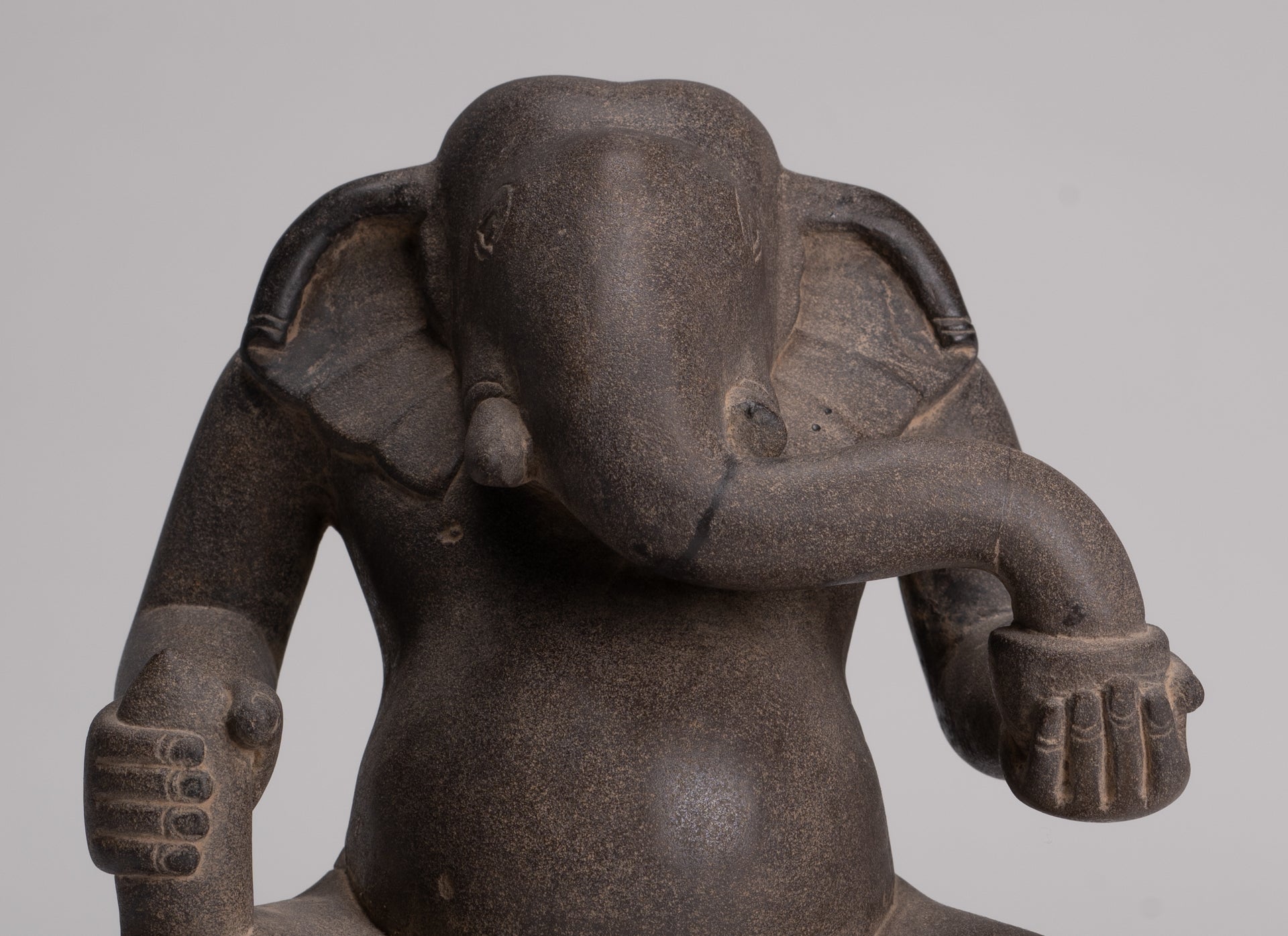-
Antique Cham Style Vietnamese Seated Stone Ganesha Statue - 19cm/8"
Measures (Height) 19cm/8"
An antique Cham style seated stone Ganesha.
The Cham Ganesha is a fascinating representation of the Hindu god Ganesha, created by the ancient Cham civilization in Southeast Asia. The Cham people, primarily known for their contributions to art and architecture, inhabited what is now central and southern Vietnam from approximately the 2nd century CE until the 19th century.
The Cham Ganesha sculptures are remarkable for their unique blend of Indian and indigenous artistic styles, reflecting the rich cultural exchange in the region.
Ganesha is the elephant headed son of Shiva. He holds a bowl of sweetmeats in his hand.
Ganesha, also known as Ganapati or Vinayaka, is one of the most revered deities in Hinduism. He is the elephant-headed god of wisdom, knowledge, and new beginnings, and is often invoked at the start of any new venture or project. Ganesha is the son of Shiva and Parvati and is recognized by his distinct elephant head and large belly. Here, he also holds his broken tooth and a bowl of laddus or sweetmeats in his hands.
Laddus is the name for Indian sweetmeats. Whilst some may interpret this as Ganesha simply having a sweet tooth or a (relatable) penchant for candy, it is no surprise that the sweet delicacies carry further meaning. These tasty treats represent the reward for a wisely-led life and the eternal sweetness that comes from a fulfilled experience. Dentists around the world will be delighted to hear that Ganesha is never depicted actually eating the sweetmeats, but this item of the deity does also show his parallels with everyday human life. This relates to Ganesha's status as a Vedic God, which means he does not forget even those who are not his devotees and instead looks out for everyone. This is communicated through his depiction as always looking upwards or at eye-level, as he is surveying all human life and is therefore not solely focussed on those praying to him.
Here Ganesha also holds the remnants of his broken tusk. The breaking of the tusk has several backstories. One instance suggests that it was shattered when Shiva cut the head off the elephant, prior to bestowing it onto Ganesha. Another writes that Ganesha's quill broke and he needed a writing instrument, try telling your boss that next time you try to write up a report with an elephant tusk because your computer crashed. Regardless of its multiple origins, the holding of the tusk represents less of a keepsake, and more of a depiction that our spirituality is more important than our outer bodies, meaning we must overcome the duality of the two as separate entities.
The direction of Ganesha's trunk has symbolic meaning. Here the trunk turns to Ganesha's left. This signifies the direction for success in the world. It is a position associated with grihastas, or householders.
The Cham Ganesha sculptures hold immense cultural and religious significance. They are not only artistic masterpieces but also serve as symbols of the syncretic nature of Cham religion, which seamlessly integrated Hindu and local beliefs. The presence of Ganesha in Cham temples indicates the widespread influence of Hinduism in Southeast Asia and the importance of Ganesha as a deity who removes obstacles and brings prosperity.
These sculptures also provide valuable insights into the cultural and artistic exchanges between India and Southeast Asia. They illustrate how the Cham people adapted and transformed Indian religious iconography to fit their own cultural context, creating a unique and enduring legacy.
His elephant features are sensitively and naturalistically rendered and blend seamlessly into the anthropomorphic figure beneath. Typical, of 8th century Cham style. A rare and delicate Cham sculpture of Ganesha.
To facilitate shipping the sculpture will be packaged in a wood crate with custom filling.
SATISFACTION GUARANTEE - We have been offering SE Asian Art for many years and are proud of the reputation we have developed for fair and honest listings. However, if for any reason, whatsoever, you are unhappy with your purchase please just let us know and we will provide a full refund. We want you to be 100% happy with your purchase.
-
The majority of orders will be shipped with DHL. This is a secure, express and fully tracked service.
Items less than 2Kg we typically ship using Royal Mail.
Once we receive your order we try to ship all orders the same or next working day.
Large and/or fragile pieces requiring palletising, specialist crating and/or extra packaging may take a little longer. Palletised shipments will be delivered curbside.
All orders over 35 GBP will be shipped free of charge.

-
We genuinely hope that all purchases delight.
However, if they do not, regardless of reason, we will refund all orders upon receipt of the unwanted item. Just notify us within 14 days of receiving your order that you wish to make a return and send the piece back to us with 30 days of delivery.
Gandhara Buddha statues mark a turning point in Buddhist art, where the Buddha was first shown in fully human form with a striking blend of Indian and Greco‑Roman aesthetics.
They are essential for understanding how Buddhism spread along the Silk Road and how visual culture translated spiritual ideas into a universal, approachable image.









































